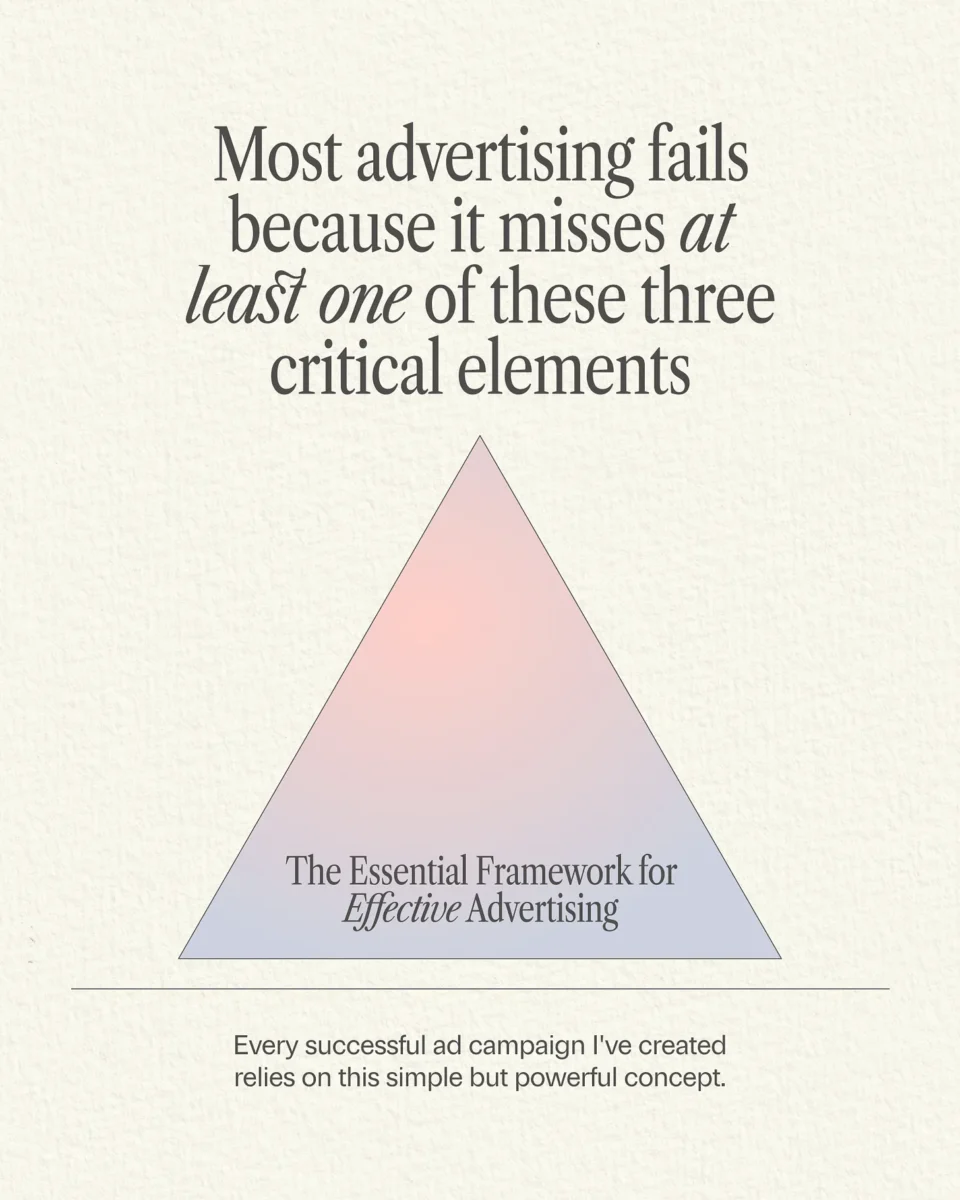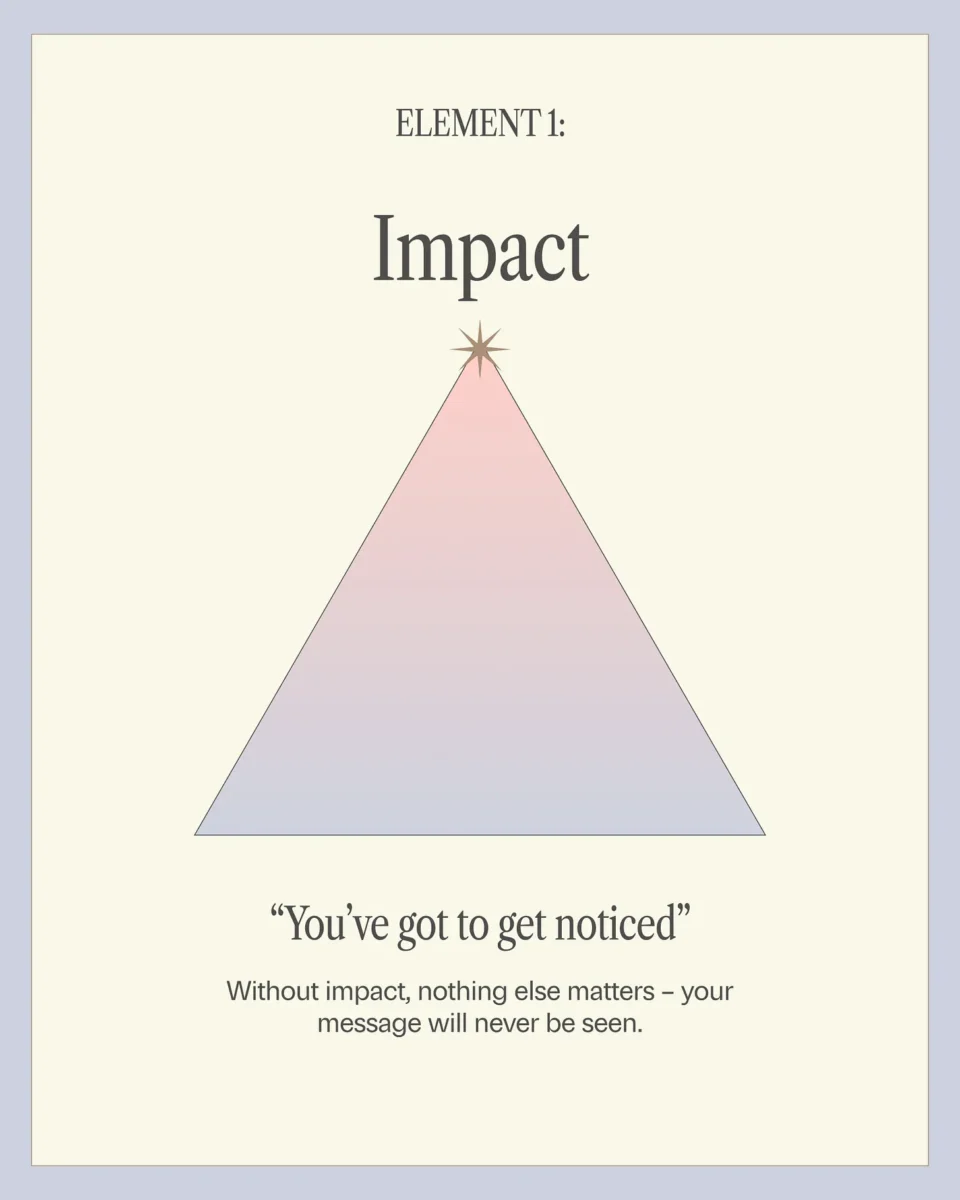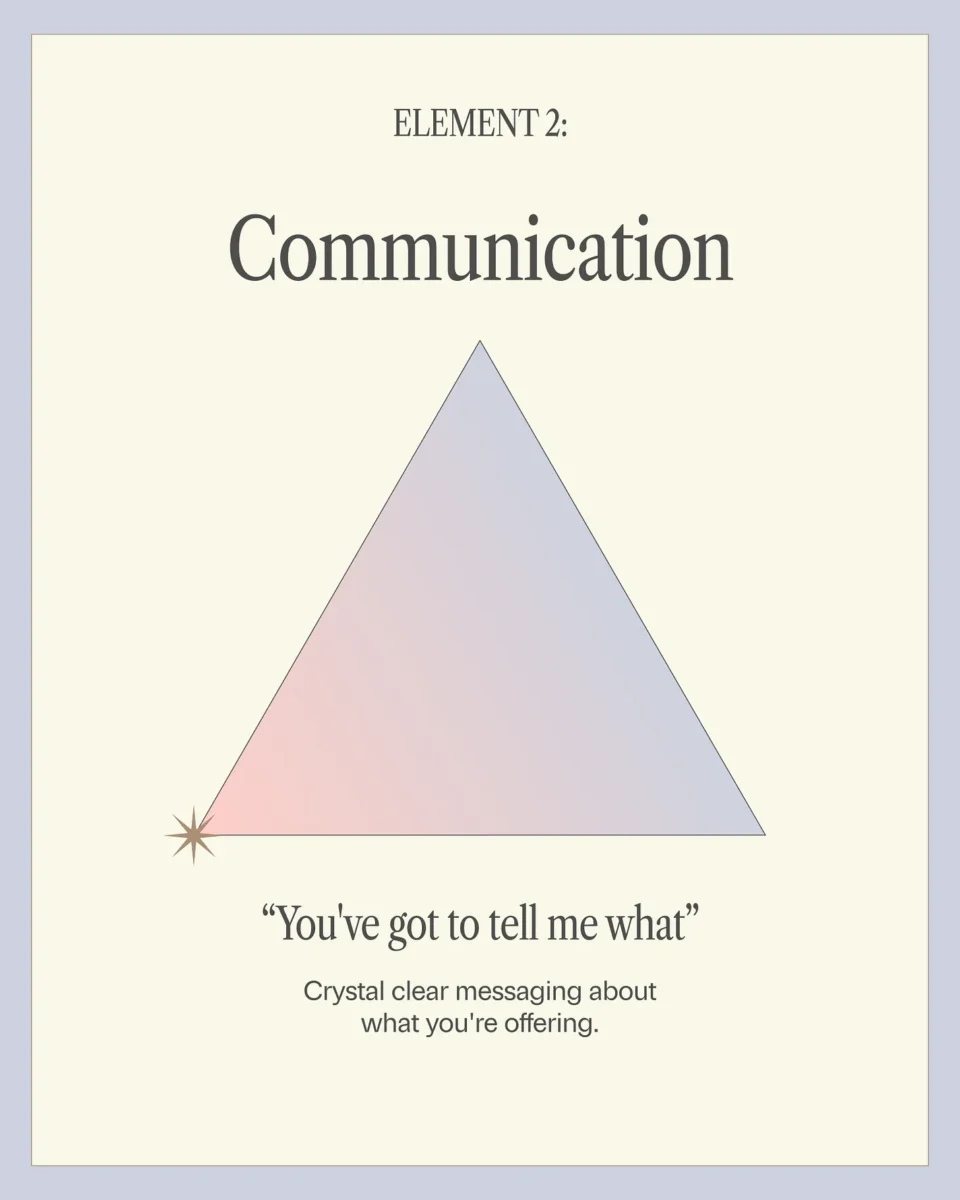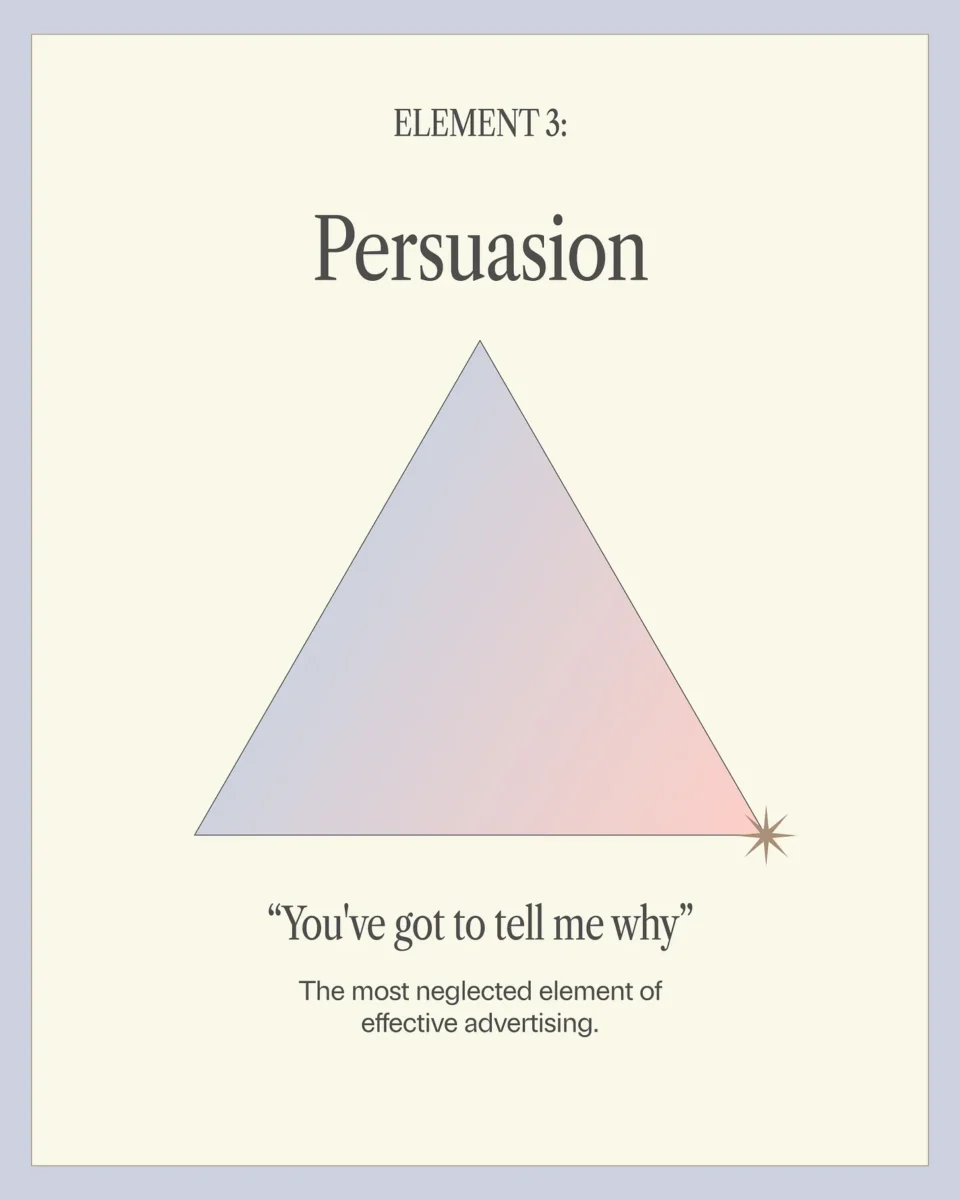
The triangle framework has fundamentally transformed my approach to advertising strategy. What makes this framework so powerful is its elegant simplicity combined with its universal applicability. This unassuming geometric shape has become the backbone of every successful campaign I’ve developed because it cuts through complexity and focuses on what truly matters. I’ve found that effective advertising always requires three essential elements:
- Impact: “You’ve got to get noticed”
- Communication: “You’ve got to tell me what”
- Persuasion: “You’ve got to tell me why”
After years of applying this framework with clients across industries, I’m convinced it’s the simplest yet most powerful tool for evaluating whether your advertising will actually work. Let me break down why I believe this so strongly.Subscribe
The Three Essential Elements

1. Impact: “You’ve got to get noticed”
The first and perhaps most critical element is impact. In today’s oversaturated media landscape, where we’re bombarded with thousands of marketing messages daily, cutting through the noise isn’t just challenging – it’s the price of entry.
What frustrates me about most advertising is that it blends right into the background. It’s forgettable. I’ve seen countless campaigns fail not because they were poorly executed but because they were invisible. Impact is about stopping the scroll. It’s about creating that moment of interruption where your potential customer pauses and gives you their most precious resource: attention.
In my experience, creating impact can take many forms – bold visuals, unexpected humor, provocative statements, or emotional storytelling. I’m not particularly concerned with the specific technique, but I am obsessed with the result: did you manage to get noticed? Without impact, everything else becomes irrelevant because your message will never be experienced.

2. Communication: “You’ve got to tell me what”
Once you’ve captured attention, you need to deliver your message with crystal clarity. This is the “communication” point of the triangle, and it answers the fundamental question: what are you offering?
I’ve always insisted that communication is about conveying your core message in the clearest, most direct way possible. It should leave no doubt about what your product or service is and what it does. While I value creativity, it should never come at the expense of clarity.
In my work with clients, I’ve found most brands excel at this element – clearly communicating their offering, features, and basic value proposition. In fact, most advertising overemphasizes this element while neglecting the others, which leads to perfectly clear messages that nobody sees or cares about.

3. Persuasion: “You’ve got to tell me why”
The final point of the triangle is often the most neglected: persuasion. I can’t stress this enough – it’s not enough to be noticed and understood. You must convince your audience that what you’re offering matters to them.
Persuasion addresses the crucial “why” question: Why should the customer care? Why is your offering relevant to their needs, desires, or problems? Why should they choose you over competitors or over doing nothing at all?
What I’ve learned is that effective persuasion requires a deep understanding of your audience, their motivations, pain points, and aspirations. It transforms product features into meaningful benefits and creates a compelling case for action. This is where I see most advertising fall short – it fails to make a genuine connection with what actually drives human decision-making.
Thanks for reading Branding With Benefits! This post is public so feel free to share it.
The Common Failure Point
In my analysis of hundreds of campaigns, I’ve observed that the vast majority fail because they focus almost exclusively on the “communication” point of the triangle while neglecting impact and persuasion. Consider this all-too-common example:
“We’re a brand agency.”
This statement clearly communicates what the company does – it hits the “communication” point of the triangle. But it fails entirely on impact (there’s nothing attention-grabbing about this generic statement) and persuasion (it gives no reason why anyone should care).
The typical response to such advertising might be:
“No kidding. I just googled that.”
This highlights the fundamental problem I see every day: without all three points of the triangle, advertising simply doesn’t work. The message may be crystal clear, but if it doesn’t get noticed or provide a compelling reason to care, it’s ultimately ineffective.
Applying the Triangle to Your Advertising
Throughout my career, I’ve developed a process for leveraging the power of the triangle. Every piece of advertising should be evaluated against all three elements:
Impact Assessment: Will this genuinely grab attention? Is it distinctive enough to stand out in its context? Does it interrupt the audience’s mental flow and make them take notice?
Communication Check: Is the message absolutely clear? Would someone encountering this ad understand what you’re offering without any additional context? Have you avoided industry jargon and marketing-speak?
Persuasion Analysis: Have you given a compelling reason to care? Does the ad speak to real customer needs or desires? Does it differentiate your offering from alternatives?
I firmly believe that only when all three points of the triangle are strong can advertising truly succeed. The balance may shift slightly depending on your specific goals and context, but none of the elements can be missing entirely.
Why I’m Committed to the Triangle
I’ve become deeply committed to this framework because it consistently delivers results regardless of the context. In a world where marketing tactics come and go with alarming frequency, the triangle stands as a timeless foundation. I’ve applied it across all media channels, from traditional TV commercials to the latest social media formats. It works for products and services, B2C and B2B, global brands and local businesses.
In a marketing world often obsessed with complex frameworks and ever-changing tactical approaches, I find myself returning to this triangle time and again because it reminds us that effective advertising ultimately comes down to three essential elements: getting noticed, clearly communicating your offering, and giving people a compelling reason to care.
By ensuring your advertising addresses all three points of the triangle, you create marketing that doesn’t just communicate – it connects, convinces, and converts. And ultimately, that’s what I’m passionate about helping brands achieve.
The Triangle in Action: Examples of Excellence
The most memorable and effective ad campaigns in history have masterfully executed all three points of the triangle:
Apple’s iconic “1984” commercial had tremendous impact through its cinematic quality and dystopian imagery, clearly communicated the introduction of the Macintosh computer, and persuaded viewers by positioning Apple as the revolutionary alternative to conformist computing.
Nike’s “Just Do It” campaign creates impact through powerful imagery of athletic achievement, clearly communicates that they sell athletic apparel, and persuades by tapping into the aspirational desire for athletic excellence and self-improvement.
Dollar Shave Club’s viral video created impact through unexpected humor, clearly communicated their subscription razor service, and persuaded viewers with the compelling value proposition of quality razors at a fraction of the price of retail brands.
Conclusion
This triangle framework has been the foundation of my approach to advertising for years. In today’s complex marketing landscape, I’m even more convinced of its value. By ensuring your advertising delivers on all three essential elements – impact, communication, and persuasion – you create messaging that doesn’t just get seen, but gets results.
The next time you’re evaluating an advertising concept, ask yourself: Does it have all three points of the triangle? If not, it’s time to go back to the drawing board. Your audience deserves advertising that respects their intelligence and their time – and your business deserves advertising that actually works.
PS. Sign up for my Social Media Masterclass for this and more!